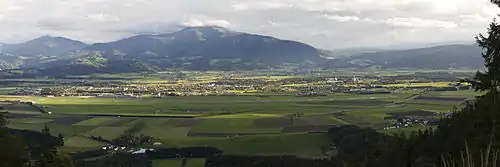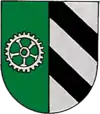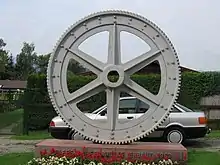Zeltweg
Zeltweg is a town in Styria, Austria. It is located in the Aichfeld basin of the Mur River in Upper Styria. Larger municipalities in the vicinity are Judenburg, Knittelfeld and Fohnsdorf.
Zeltweg | |
|---|---|
 View from the north | |
 Coat of arms | |
 Zeltweg Location within Austria | |
| Coordinates: 47°11′26″N 14°45′04″E | |
| Country | Austria |
| State | Styria |
| District | Murtal |
| Government | |
| • Mayor | Günter Reichhold (SPÖ) |
| Area | |
| • Total | 8.67 km2 (3.35 sq mi) |
| Elevation | 659 m (2,162 ft) |
| Population (2018-01-01)[2] | |
| • Total | 7,212 |
| • Density | 830/km2 (2,200/sq mi) |
| Time zone | UTC+1 (CET) |
| • Summer (DST) | UTC+2 (CEST) |
| Postal code | 8740 |
| Area code | 03577 |
| Vehicle registration | JU |
| Website | www.zeltweg.at |
History
Some farms were recorded at Zeltweg in the Duchy of Styria already during the 13th century. The village then was called Celtwich, its name being recorded in 1430 for the first time. During the 15th century, there were considerable difficulties resulting from famines, failed harvests and epidemics, From 1569 onwards, the Habsburg archduke Charles II of Austria initiated the rafting of timber down the Mur, which gained considerable importance for Zeltweg's history. During the following decades, Zeltweg grew and was a target of migration.
During the 18th century, the population shrank considerably because of the expansion of roads. In 1848, Count Hugo Henckel von Donnersmarck, who came from Upper Silesia, decided to relocate his family's smeltery from Carinthian Frantschach-Sankt Gertraud to the site. This industrial revolution brought a boom for Zeltweg. A railway station was built in 1868. Zeltweg was detached from neighbouring Fohnsdorf as a municipality in its own right and the first mayor, Heinrich Dillinger, was elected in 1875.
After the Austrian Anschluss in 1938, the Zeltweg ironworks were incorporated into the Reichswerke Hermann Göring conglomerate, employing numerous unfree labourers during World War II. At the end of the war, Zeltweg was first occupied by Soviet and then British troops. Still, there was an upswing both in education and in industry after the war. Zeltweg received town privileges on 1 January 1966.
Main sights

Zeltweg's main attraction is the Farrach Palace, built by Carl Friedrich von Teufenbach between 1670 and 1680 in the style of an Italian Renaissance palace. Stucco works were installed inside.
Since 1986, the palace is owned by Anton and Ingrid Hartleb, who refurbished it and transformed it a site for cultural and artistic events.
Zeltweg's coat of arms is a cog and a human sized one was erected at the railway bridge to show that Zeltweg was an industrial town.
Climate
| Climate data for Zeltweg | |||||||||||||
|---|---|---|---|---|---|---|---|---|---|---|---|---|---|
| Month | Jan | Feb | Mar | Apr | May | Jun | Jul | Aug | Sep | Oct | Nov | Dec | Year |
| Average high °C (°F) | −3 (26) |
4 (39) |
9 (48) |
13 (56) |
17 (62) |
22 (71) |
23 (73) |
23 (73) |
20 (68) |
14 (57) |
6 (42) |
1 (34) |
12 (54) |
| Average low °C (°F) | −13 (8) |
−8 (17) |
−3 (27) |
1 (34) |
4 (40) |
8 (46) |
9 (48) |
9 (48) |
7 (44) |
3 (38) |
−3 (27) |
−8 (18) |
1 (33) |
| Average precipitation mm (inches) | 120 (4.9) |
28 (1.1) |
28 (1.1) |
61 (2.4) |
110 (4.5) |
64 (2.5) |
110 (4.3) |
110 (4.3) |
74 (2.9) |
160 (6.2) |
46 (1.8) |
33 (1.3) |
950 (37.3) |
| Source: Weatherbase [3] | |||||||||||||
Economy
The most important industries are mechanical engineering, the packaging industry, and timber. Furthermore, Austria's largest military airport, Zeltweg Airfield (Fliegerhorst Hinterstoisser) operated by the Austrian Air Force is located here, which was built in 1937.
Motorsport
The Zeltweg Airfield was used as a racing circuit in the 1960s and hosted the Formula One Grand Prix in 1964. The track was abandoned in 1969 with the construction of the Österreichring, a purpose built motorsport track in Spielberg.
Transportation
The center of Zeltweg was strongly polluted by truck traffic, as a large proportion of the traffic coming from Wolfsberg and Obdach (including log wood, hacked wood and packaged goods) had to be brought through the town. For that reason, a by-pass was built and opened on 3 November 2004. The expressway is 4.5 km long, cost €11 million and also saves Judenburg and Fisching from traffic.
Education
In Zeltweg, there are, among others, two elementary schools, one Hauptschule (junior high school) (the two Hauptschulen were merged in 2002) and a vocational high school machine construction and building.
AC/DC-Rock or Bust World Tour
On 14 May 2015 Zeltweg hosted one of the biggest rock bands in the world, AC/DC, on their Rock or Bust World Tour. It was the largest concert ever in Austria, with an audience of 105,042 people.
References
- "Dauersiedlungsraum der Gemeinden Politischen Bezirke und Bundesländer - Gebietsstand 1.1.2018". Statistics Austria. Retrieved 10 March 2019.
- "Einwohnerzahl 1.1.2018 nach Gemeinden mit Status, Gebietsstand 1.1.2018". Statistics Austria. Retrieved 9 March 2019.
- "Weatherbase: Historical Weather for Zeltweg, Austria". Weatherbase. 2011. Retrieved on November 24, 2011.
